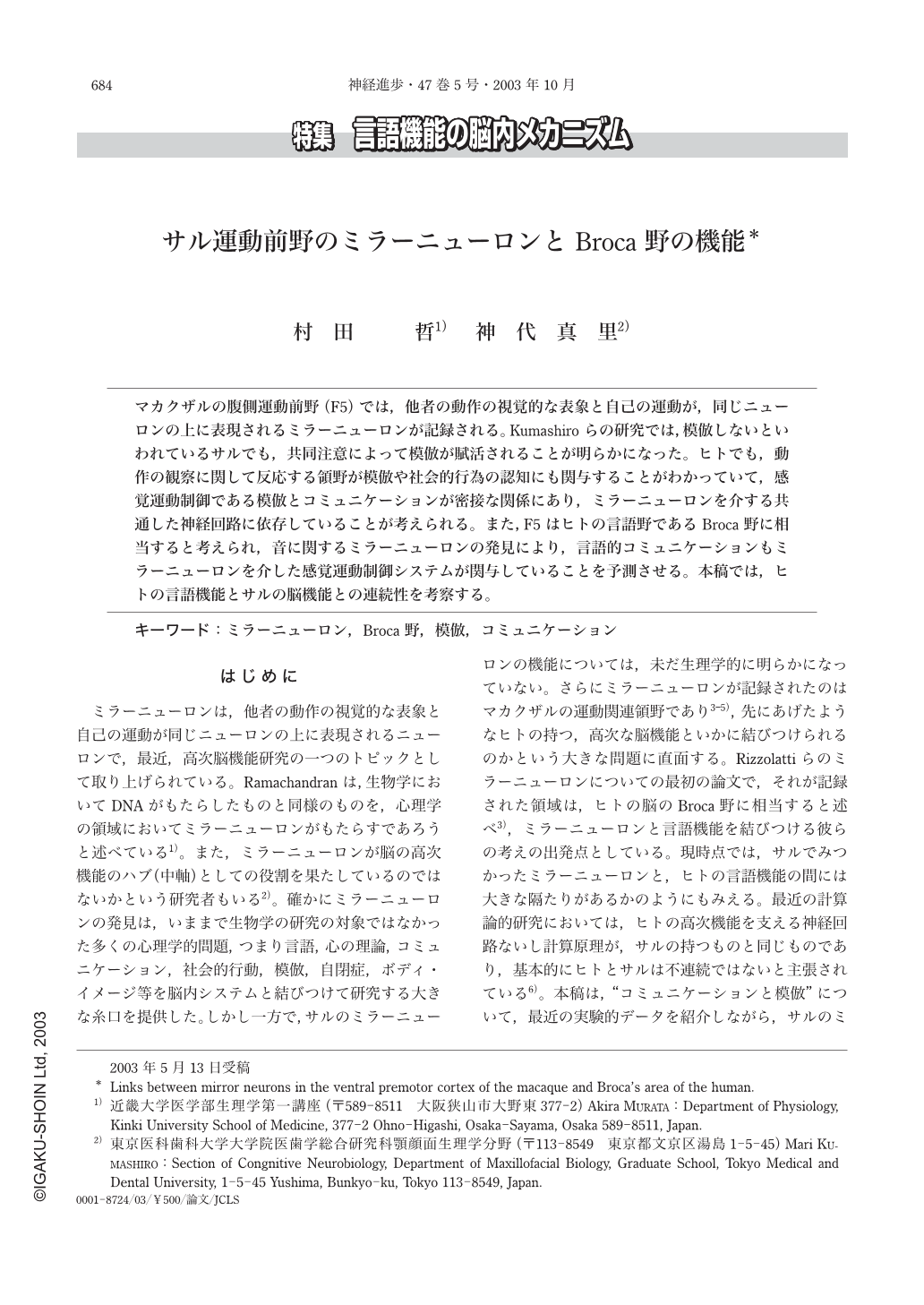Japanese
English
- 有料閲覧
- Abstract 文献概要
- 1ページ目 Look Inside
マカクザルの腹側運動前野(F5)では,他者の動作の視覚的な表象と自己の運動が,同じニューロンの上に表現されるミラーニューロンが記録される。Kumashiroらの研究では,模倣しないといわれているサルでも,共同注意によって模倣が賦活されることが明らかになった。ヒトでも,動作の観察に関して反応する領野が模倣や社会的行為の認知にも関与することがわかっていて,感覚運動制御である模倣とコミュニケーションが密接な関係にあり,ミラーニューロンを介する共通した神経回路に依存していることが考えられる。また,F5はヒトの言語野であるBroca野に相当すると考えられ,音に関するミラーニューロンの発見により,言語的コミュニケーションもミラーニューロンを介した感覚運動制御システムが関与していることを予測させる。本稿では,ヒトの言語機能とサルの脳機能との連続性を考察する。
はじめに
ミラーニューロンは,他者の動作の視覚的な表象と自己の運動が同じニューロンの上に表現されるニューロンで,最近,高次脳機能研究の一つのトピックとして取り上げられている。Ramachandranは,生物学においてDNAがもたらしたものと同様のものを,心理学の領域においてミラーニューロンがもたらすであろうと述べている1)。また,ミラーニューロンが脳の高次機能のハブ(中軸)としての役割を果たしているのではないかという研究者もいる2)。確かにミラーニューロンの発見は,いままで生物学の研究の対象ではなかった多くの心理学的問題,つまり言語,心の理論,コミュニケーション,社会的行動,模倣,自閉症,ボディ・イメージ等を脳内システムと結びつけて研究する大きな糸口を提供した。しかし一方で,サルのミラーニューロンの機能については,未だ生理学的に明らかになっていない。さらにミラーニューロンが記録されたのはマカクザルの運動関連領野であり3-5),先にあげたようなヒトの持つ,高次な脳機能といかに結びつけられるのかという大きな問題に直面する。Rizzolattiらのミラーニューロンについての最初の論文で,それが記録された領域は,ヒトの脳のBroca野に相当すると述べ3),ミラーニューロンと言語機能を結びつける彼らの考えの出発点としている。現時点では,サルでみつかったミラーニューロンと,ヒトの言語機能の間には大きな隔たりがあるかのようにもみえる。最近の計算論的研究においては,ヒトの高次機能を支える神経回路ないし計算原理が,サルの持つものと同じものであり,基本的にヒトとサルは不連続ではないと主張されている6)。本稿は,“コミュニケーションと模倣”について,最近の実験的データを紹介しながら,サルのミラーニューロンの役割とヒトのコミュニケーション能力のリンクを考察する。
In this article, we try to discuss common neuronal mechanisms for communication in the macaque monkey and human. In the monkey ventral premotor cortex(F5), mirror neurons were found by Rizzolatti's group(Rizzolatti et al, 1996). These neurons were active during execution of the hand or mouth action and the observing same action made by another individual. Since these neurons coded the visual representation of action onto the motor representation, they call it direct-matching system. Mirror neurons were recorded also in a part of the inferior parietal cortex(area PF). A cluster of neurons in the superior temporal sulcus(STSa)was responded during observing biological motion. F5, PF and STSa construct a network for the action recognition;mirror system. Rizzolatti and Arbib(1998)suggested that mirror system might be precursor of the language system. However, it seems that there are long distance between the human language and mirror system. The problem is that the function of mirror neurons in the premotor cortex of the macaque is still uncertain, because it is usually accepted that the ability of communication and imitation in the monkey are very limited.
However, recent behavioral studies revealed that the monkeys could establish bidirectional communication with joint attention by eye gaze and pointing, which is a basic communicative behavior. Furthermore, Kumashiro et al.(2003)have found that joint attention develops the ability of imitation in the monkeys. This means that as in the human development the imitation has a tight connection with the communication in the monkey. Direct matching of the observed action and internal motor representation should be useful for imitation. Joint attention per se may include a component of eye gaze or pointing recognition by others and overt execution by own. The idea is that systems for imitation and communication might share a common neural circuit, namely mirror system in the monkeys. Gallese&Goldman(1998)suggested that mirror neurons might be related to simulation theory, in which systems predicted internal representation in the other individuals. Actually resent computational neuroscience studies showed that the communication and imitation could be achieved by the common computational principles, based on simulation theory.
The verbal communication may be on the same line. Recently, sound mirror neurons were found in the monkey F5, which were activated during hearing sound of action and executing same action(Kohler et al, 2002). Also in the human, transcranial magnetic stimulation study revealed that speech listening facilitated motor evoked potential from the listeners'tongue muscles when the presented words involved tongue movement(Fadiga et al, 2002). These evidences demonstrate that both in the monkey and human mirror system involve direct matching of the hearing action and internal motor representation, and this may be useful for communication, predicting internal representation of others by speech or sounds.
Cytoarchitectonically, it is suggested that at least area 44, part of Broca's area, is the human homologous of monkey F5. Neuroimaging studies showed that area 44 was activated with movement control or imitation of the hand. Broca's area may be concerned with not only verbal function, but also sensory motor control. Language production per se includes aspects of sensory motor control. In conclusion, the ability of language communication may have some links from monkey's sensory motor control system, namely mirror system involved ventral premotor cortex.

Copyright © 2003, Igaku-Shoin Ltd. All rights reserved.


